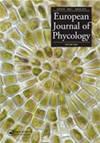Dispersal of populations and environmental deterioration rate influence evolutionary rescue under selection by salinity in the freshwater cyanobacterium Microcystis aeruginosa
IF 1.7
4区 生物学
Q2 MARINE & FRESHWATER BIOLOGY
引用次数: 0
Abstract
ABSTRACT Evolutionary rescue (ER) occurs when adaptation prevents extinction under lethal selection. However, the lack of empirical studies addressing the possible factors enabling ER limits our understanding of the current biodiversity crisis in the context of global change. Here we addressed the roles of environmental deterioration rate and dispersal of metapopulations on the dynamics of ER in the freshwater cyanobacterium Microcystis aeruginosa exposed to lethal salinity levels. We exposed M. aeruginosa to six combinations of two environmental deterioration rates (control = no deterioration, and progressive deterioration). Populations under progressive deterioration started with five different NaCl concentrations (from 0 to 4 g l–1 NaCl), with 2 g l–1 NaCl added twice at 4-week intervals, followed by a final increase of 4 g l–1 NaCl. Final concentrations in the experiment ranged from 8 to 12 g l–1 NaCl. Populations with no deterioration treatment spent 12 weeks in the initial concentration and were suddenly shifted to the final range concentration. To determine the effects of dispersal on the number of ER events, three dispersal modes were implemented: (i) populations were not mixed (no dispersal); (ii) six replicate populations of the same NaCl concentration were mixed together (local dispersal); and (iii) all populations of the same metapopulation were mixed together (global dispersal). Both dispersal mode and deterioration rate were very strong predictors of the ER outcome in each metapopulation. Specifically, dispersal among populations and prior stress exposure favoured the occurrence of ER events.在盐度选择下,种群的分散和环境恶化率影响着淡水蓝藻绿微囊藻的进化拯救
进化拯救(Evolutionary rescue, ER)是指在致死选择下,适应阻止了物种灭绝。然而,缺乏实证研究解决了可能的因素,限制了我们对当前全球变化背景下生物多样性危机的理解。本文研究了环境恶化率和超种群扩散对暴露于致死盐度水平的淡水蓝藻绿微囊藻内质网动态的影响。我们将铜绿假单胞菌暴露于两种环境恶化率(对照=无恶化和渐进性恶化)的六种组合中。进行性退化群体从5种不同的NaCl浓度(0 ~ 4 g l-1 NaCl)开始,每4周添加2次2 g l-1 NaCl,最后增加4 g l-1 NaCl。实验最终浓度为8 ~ 12 g l-1 NaCl。未恶化处理的种群在初始浓度下停留12周,然后突然转移到最终范围浓度。为了确定扩散对ER事件数量的影响,采用了三种扩散模式:(i)种群不混合(不扩散);(ii)将相同NaCl浓度的6个重复群体混合在一起(局部分散);(iii)同一元种群的所有种群混合在一起(全球分散)。扩散模式和恶化率都是每个元种群ER结果的非常强的预测因子。具体来说,种群间的分散和先前的应激暴露有利于内质网事件的发生。
本文章由计算机程序翻译,如有差异,请以英文原文为准。
求助全文
约1分钟内获得全文
求助全文
来源期刊

European Journal of Phycology
生物-海洋与淡水生物学
CiteScore
4.80
自引率
4.20%
发文量
37
审稿时长
>12 weeks
期刊介绍:
The European Journal of Phycology is an important focus for the activities of algal researchers all over the world. The Editors-in-Chief are assisted by an international team of Associate Editors who are experts in the following fields: macroalgal ecology, microalgal ecology, physiology and biochemistry, cell biology, molecular biology, macroalgal and microalgal systematics, applied phycology and biotechnology. The European Journal of Phycology publishes papers on all aspects of algae, including cyanobacteria. Articles may be in the form of primary research papers and reviews of topical subjects.
The journal publishes high quality research and is well cited, with a consistently good Impact Factor.
 求助内容:
求助内容: 应助结果提醒方式:
应助结果提醒方式:


